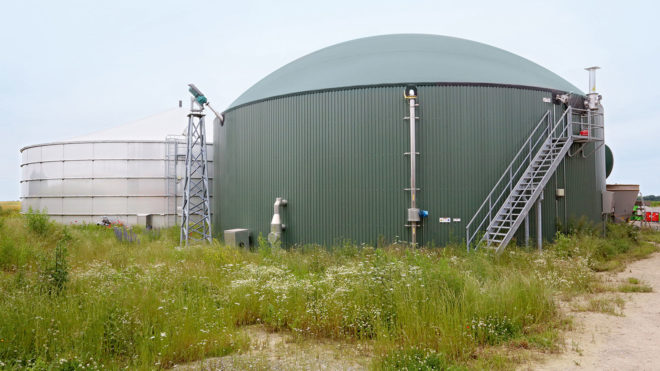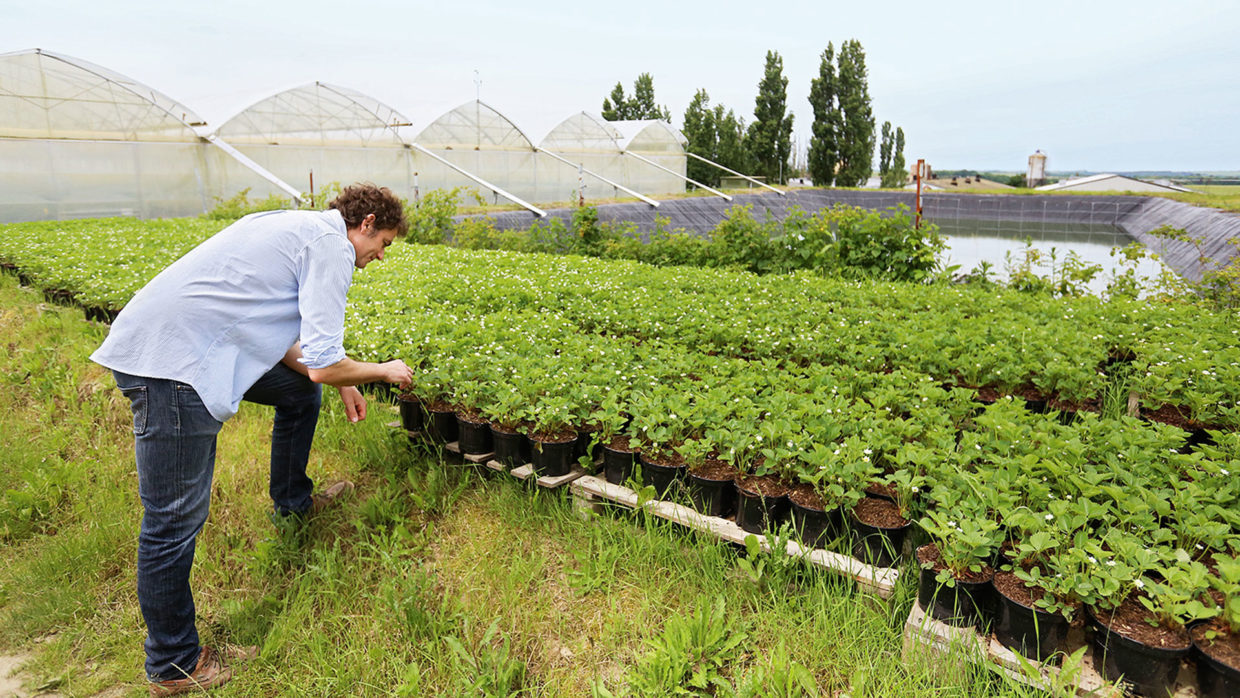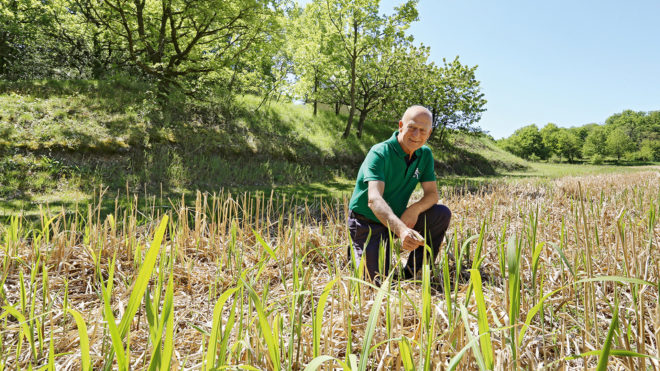Converting waste, byproducts, or biomass into energy to heat buildings or greenhouses is not a new idea, but the improved self-sufficiency is still attractive. In the department of Aisne, the Mascourt farm has chosen anaerobic digestion, on the initiative of Sébastien Mascourt, who is passionately committed to this project.
“Having already farmed pigs and about 250ac, in 2004 I started thinking about how to sustain the structure of the farm, which I manage together with my sister and brother-in-law. I made a bet on energy transition and explored all the potential that there was on the farm. For a pig farm, there are not very many solutions besides thermal energy.”
Cogeneration
After gaining approval from the local planning authority, in 2014 Sébastien set up his cogeneration-anaerobic digestion plant, with a capacity of 250kW. He made the choice to treat the 12,000t of manure from his pig farm to heat the new greenhouses that he has built on the farm. Greenhouses in Picardy? For growing what? Red berries! The young farmer didn’t hesitate: he used about 2.5ac of the land for greenhouses to produce 44t of berries a year and recruited 15 people to help with the harvest between April and November.
“By pooling our three activities relating to pigs, strawberries, and anaerobic digestion, we have created synergy effects and large-scale energy economies.”
Sébastien Manscourt
The farm shop sales are negligible, the majority of the fruit going to a commercial platform in Laon, a nearby town. “I still keep a bit of the direct sale, which allows us to have some contact with customers and explain how we produce the fruit, with practically no treatment.”
Job creation
The project is going well; the farm produces strawberries for local sales outlets over six months, with seven varieties in total. They are grown above ground, with no treatment besides essential oils to prevent diseases, and the collecting baskets are weeded by hand. It’s not quite organic, but it’s close. Additionally, Sébastien sowed wild plants, like sainfoin and melilotus, around the greenhouses to attract bees and other pollinators to the strawberry plants.
Over half of the greenhouses are heated by the anaerobic digestion unit and the hot water that it produces. After two years of operation, Sébastien calculates that it will take another five years for the equipment to pay itself off. In total, four million euros have been invested over five years and today 22 people work on the farm.

In Picardy, the Manscourt collective farm is putting all its efforts into anaerobic digestion through cogeneration, from livestock manure but also from all sources of organic waste available in the area of the farm.
Harnessing the local biomass
These two years were needed to get good points of reference. Sébastien mentions that he has spent many hours monitoring and regulating his anaerobic digestion plant. In his opinion, it’s only a first step. He is contemplating building air-conditioned storage facilities. “At the moment this anaerobic digestion unit runs on 60% manure and 40% green waste. But I don’t have enough power to heat all my greenhouses. Hence the idea of expanding the anaerobic digestion unit by converting unused biomass, from local sources of waste.”
He already plans to build a grain store on the farm and he hopes to increase his capacity by doubling the number of his livestock and to convert more manure into fuel. His dream is to triple or quadruple the plant’s capacity and to achieve complete energy self-sufficiency. “Today, our three activities relating to pigs, strawberries, and anaerobic digestion are interdependent. By pooling them, we are creating synergy effects and large-scale energy economies.”

With his passion for producing strawberries, Sébastien Manscourt breeds the finest varieties of the plants himself.
Miscanthus fuel
Another energy sector is taking root, and that is miscanthus. One of the latest successes involves heating the Abbey of Ourscamp in Oise with 30ac of the plant produced locally by two farms very close by. The miscanthus supply has been contracted for 15 years. The farmers seeded it in 2015 on plots that were far from the farms and difficult to access, where grain crops were not very profitable.
This outlet allows them to diversify their activity, secure a stream of revenue and recover the investment in planting rhizomes. The religious community of Ourscamp has installed its new 400kW miscanthus heating system, replacing the old oil heaters, to heat four buildings and three houses. This saves the abbey €60,000 per year in fuel and avoids 230t of CO2 emissions per year. By way of comparison, those are the same emissions as 120 new diesel vehicles (183g CO2/mi, 9,630mi/year) produce.
Further south in Drôme, Jacques Vaillant is also exploring every source of energy self-sufficiency. This former physics teacher has many ideas that he is trying to get out into the rural world. In Montéléger, he has set himself up on a former farm surrounded by just over 5ac of land. “I have been trying to eliminate my carbon footprint for 12 years,” he says. All means of doing so are good: insulating your home with wood wool, small wind turbines, water heater and solar panels, not to mention planting miscanthus to power a plant furnace.
ANAEROBIC DIGESTION AND BIOGAS OUTLETS
Anaerobic digestion is a natural process of decomposition of organic material, leading to the production of biogas, which can put to use in multiple ways:
- just for heat (in a boiler)
- electricity and heat simultaneously (in cogeneration)
- biomethane, which can be injected into the natural gas network and used for any traditional use of natural gas, including for fuel use.
Undemanding crop
“Today I have done away with fossil fuel completely by insulating the walls and using the miscanthus heather. I planted this grass myself at two feet per square meter. It’s worth noting that this crop is not invasive at all. Instead it’s economical, sustainable, and easy to grow.” Giant miscanthus, also known as elephant grass (Miscanthus giganteus) is sterile. And when it is fall, we see panicles appear that do not contain seeds: that means it is not considered an invasive species.
On Jacques Vaillant’s farm, the miscanthus is grown on just under two and a half acres and is harvested in March when the stems are well dried out. Yield (dry matter) is 4.8 to 5.7t/ac/year on average. Once ensiled, the harvest is stored under cover, before going straight into the boiler, supplied by an auger.
Jacques Vaillant regrets not having found a suitable boiler in France. In the end he imported it from Austria. “This agricultural boiler allows us to burn any primary agricultural material. All we need to do is make a lining, since the acids produced by the combustion attack the internal surfaces. The clinker also has to be eliminated with a grille. Finally, the quantity of air needs to be carefully regulated by an oxygen probe placed at the exhaust.”
A step towards self-sufficiency
Always willing to share his experience, the retired teacher has set up an association in Drôme in order to promote the benefit of miscanthus for housing. “I think that with a little over an acre of miscanthus, anyone could heat their home. And a farmer can also use it to run his drying facilities and buildings”, he adds. “We need to move to renewable energy and for everyone to manage to limit their carbon emissions to less than 2t/year… otherwise our world is headed for disaster!”
MISCANTHUS BIOFUEL
There are multiple upsides to dry-harvested miscanthus:
- a yield of 25 to 70t/ac
- the sustainable plant forms a soil mulch when the leaves fall in autumn, which avoids any chemical or mechanical weeding
- high calorific output (4.4MW/t of dry material) comparable to that of wood with a higher ratio of dry material
- 7t/ac of miscanthus produce the equivalent of more than 2,400l of mineral oil


